Planting and care in the open field.
Creeping weeds. Plants of this group breed by parts of above-ground shoots (whiskers). These include creeping buttercup, ivy-shaped bud, and silverweed goose. [...]
The creeping buttercup - Ranunculus repens L.- belongs to the ranunculus family. It is widespread, it prefers moist, wet places on heavy clay soils and peatlands. Weeds litter the vegetable, floodplain meadows and pastures. The plant is poisonous. [...]
Buttercup creeping - Ranunculus repens L. Bare or weakly-raised plant with a lying or rising stem 15-50 cm long (see fig. 86). Stem cylindrical, shiny, rooted in nodes with the formation of daughter plants. Lower leaves petiolate, trifoliate, their leaflets on petiole-kah, three times dissected, with jagged lobes. Upper leaves almost sessile, deeply fissured, dentate lobes. Leaf plates from below are lighter and with a clear network of veins. Flowers solitary, on furrowed pedicels. Petals of zolotis-yellow, twice as long as the bare sepals [...]
Perennial creeping - creeping buttercup, cinquefoil gooseneck, ivy bud-ra - litter tilled crops and grains. The reproduction is mainly vegetative due to the creeping and rooting shoots in the nodes. Soil fertility is undemanding, hygrophilous. [...]
The following herbicides can be used to control the buttercup creeping and other types of buttercups. [...]
Vegetative reproduction is also pronounced along with seed from a buttercup creeping. In the first year, the plant formed from the seed forms a rosette of leaves with a diameter of up to 10 cm and a fibrous root system located in the arable layer. The formation and growth of creeping shoots are usually observed next year, when one plant can form up to 25 daughter rosettes from stem nodes. [...]
In accounting for the creeping buttercup population (Ranunculus repens) on an old permanently used pasture in North Wales (Sarukhan, Harper, 1973; Sarukhan, 1974), the distribution of mature plants and seedlings was mapped in detail (this rarely succeeds in mobile animals). Dying off occurred year-round, with its seasonal peaks coinciding in time with the maximum growth rate of the surviving plants. Replenishment of the population occurred in two ways: due to the annual explosive germination of seeds and clonal reproduction. In the latter case, the plant forms rosettes of leaves and axillary buds, which develop into long stolons; At the end of each of them, a new rooting outlet appears. Any outlet can thus give a number of child clonal outlets; the latter, in turn, form their stolons and rosettes during the same vegetation period, etc. As a result, one genotype can be represented by a whole family of rosettes. Each plant develops into a subpopulation of its parts, capable of losing touch with each other, but remaining modules of a single from a genetic point of view of an individual. [...]
In tab. 15.1 presents the results of studying the population dynamics of a creeping buttercup on three separate plots of 1 m2. From the table it is clear the effect of fertility and mortality on the overall size of the population (Fig. 15.1). It can be seen that the fate of a population depends on the fate of the individual constituent organisms. It is individuals who are born and die, leave offspring or remain barren. Despite these dynamic processes underlying the changes in the population, it has remained surprisingly stable in the buttercup creeping for two years of research. [...]
The herbaceous vegetation of the undergrowth is formed by hybrid clover, alpine clover, creeping buttercup, many-sided blue lupine, forest wild strawberry, St. John's wort, dandelion, Rapunzel bell, two-leaf myannic. [...]
Ecological criterion is a combination of environmental factors in which a species exists. For example, a caustic buttercup is common in meadows and fields; In more damp places, a creeping buttercup grows, and on the banks of rivers and ponds, in marshy places, a burning buttercup is found. [...]
If there is no indicator paper, then look at what weeds are growing on the plot. If it is a sorrel, a fragrant spikelet, a creeping buttercup, various sedges, moss, heather, it means that the soil is strongly acidic. On the tributary, red clover, alfalfa, foxtail acidity has a depressing and sometimes detrimental effect. A large number of quinoa and nettle indicates a weak acidity of the soil. However, all these definitions are indicative, although they may be useful. After all, the acidity of the soil on the site may be unequal. [...]
Selbourne Swifts: Stability - from 1978 to 1983 - British herons: stability, despite adverse conditions. - Buttercup creeping: the stability of the population size, despite the dynamism of its composition. - Thrips: fluctuating population. [...]
Sometimes the buttercup fruits are eaten by birds and spread with excrement (eidosoo-horn). It is known that the starling, eating mainly insects and their larvae, eats and fruits of plants, in particular, some buttercups, anemone. In the sparrow's excrement, the creeping semoia buttercup is found. It was also established that reindeer in the arctic regions eat seeds of several types of buttercup (creeping buttercup - RanunculiiH heroin, hyperborean buttercup - R. hyperbomis, glacial buttercup - R. glacialis, Laplands buttercup - R. Japponicus, etc.) and alpine basiliscus and excrement spreads them. [...]
Creeping plants are plants with horizontal shoots that lie down and may root in the process of growth. Creeping trees are called stanians (elfin cedar), shrubs - elfin (polar willow, rhododendron species), grasses with short shoots - creeping (creeping buttercup, etc.). These plant life forms are the result of adaptation to adverse environmental conditions (low temperatures, strong winds, permafrost, etc.). Creeping plants are mainly found in the polar regions (Arctic deserts, tundra) and in the highland areas. [...]
This includes shallow and floating plants. [...]
By the nature of tillering, rhizome, vegetatively propagating plants (yarrow, coltsfoot, yellow bed-moth, field mint, Veronica dlinnolistnaya, etc.) are found among the herbs; Bush m and about the th and N and K and with a fibrous root system (cornflower, species of buttercup, autumn kulbaba, etc.); creeping plants that form on the surface fairly long shoots attached to the soil by adventitious roots, extending from the nodes of the shoots (creeping buttercup, silverweed goose, etc.); p-green plants with basal leaves located around the root collar and tightly pressed to the soil (plantain average, marsh bodywalk, etc.). [...]
In relation to the water regime, terrestrial organisms are divided into three main ecological groups: hygrophilic (moisture-loving), xerophilic (sukholbyivye) and mesophilic (pre-moderate humidity). An example of hygrophilia among plants is marsh marsh marigold, common oxygen, creeping buttercup, logical chisel, etc .; among the animals there are biting midges, mosquitoes, mosquitoes, dragonflies, ground beetles, it is really. All of them do not tolerate a significant water deficit and do not tolerate even a short-term drought. [...]
The need for liming approximately] can be determined by the state of some cultivated plants and the development of weeds. Poor growth and severe thinning of clover, alfalfa, beet, winter wheat and other crops sensitive to high acidity (despite ¡good agricultural practices, correct ¡fertilizer and other favorable conditions) indicate the need for liming. Some weeds and wild plants: oxholes, field thorns, pikulnik, creeping buttercup, belous, pike, russes, bogulnik, heather, grow well on acidic soils. Their abundant distribution in the fields and meadows indicates a high acidity of the soil and the need to add lime. Horsetail most often also grows on acidic soils, but it can also grow on neutral soils. [...]
Clay penetrates into plants through leaves and roots, inhibits the action of the enzyme acetolactic synthase, inhibiting the process of cell division and growth in sensitive plants, which die in 1-3 weeks or fall far behind in growth. The basis of selectively clay-resistant plants is the rapid metabolism of the herbicide to non-toxic compounds. For example, in wheat leaves, 95% of the herbicide was metabolized in 24 hours, whereas in the highly sensitive form, sugar beet, it was only 3%. Weeds sensitive to clay: white mary, shepherd's purse, chaff, Pikul nick, tepid chamomile, odorless, forget-me-not, creeping buttercup, field mustard, sow thistle, pink thistle, star sprocket, etc. , fire, dymyanki drug, wheat grass, field convolvulus, Syti.
They have become an integral part of songs, poems and legends, and this despite the far from tender name that the flower received for its poisonousness and boisterous action. Only here this plant was decided not to be called “fierce”, having applied the pet shape “buttercup”. About the healing properties of this plant, its types, medicinal properties and application will be discussed in this article.
Description of the plant buttercup (Ranunculus)
Buttercup is a perennial or annual plant belonging to the family of buttercups.Buttercup in popular literature is referred to as "ranunculus" (transliteration of the Latin name "ranunculus" is used, which translated from Latin means "little frog"). The fact is that wild buttercups, like frogs, prefer wet and swampy “habitats”, which should be quite sunny and warm.
In Russia, this plant was given the name "buttercup" for a boil.
What does a buttercup look like?
Buttercup is a rhizomatous or root-tuberous plant with upright, ascending or open-stemmed stems that often root in the nodes.Buttercup stalk height reaches from 20 cm to 1 m.
The leaves of the plant can be whole, shovel-shaped, palmate-or pinniped, they are arranged in a regular order. The petals at the base have a honey fossa (sometimes bare or covered with a small scale). Lower stem, as well as basal leaves, reach a length of 5 - 6 cm, and in width - about 5 cm.
Buttercup flowers are single or gathered in inflorescence. The diameter of the flowers - 1 - 2 cm.
The flower of a flower is a multi-tip, in which naked or hairy seeds are formed, which can be both flat and convex.
What color are buttercups?
The color range of buttercups is very diverse. This flower can be yellow, white, pink, red, lilac and blue.Where is growing?
Buttercup grows almost throughout Europe, in the Caucasus and in Western Siberia, in Asia, the Alps, and the Pyrenees, but most often this plant can be found in the wild in the temperate zone of the Northern Hemisphere.In Russia, buttercup is common in the European part of the country (with the exception of the Far North, as well as the south).
This beautiful flower prefers forest and floodplain meadows, sparse forests, banks of streams and rivers, the outskirts of marshes.
Types of buttercup
There are about 600 species of buttercups, distributed throughout the world, with many varieties having medicinal properties, thanks to which they are used in traditional medicine.The following types of buttercup are used for medical purposes:
- acrid (or night blindness);
- poisonous;
- creeping;
- burning;
- many-flowered;
- field;
- water (or marsh).
Buttercup caustic (night blindness)
Buttercup caustic (or Ranunculus acris) reaches a height of 30 - 100 cm. The stalk of this type of buttercup is erect and covered with adpressed hairs, while upwards the stalk begins to branch.The rhizome of the buttercup is caustic short, numerous roots depart from it, which are collected in a bundle.
Bright golden-yellow flowers of the correct form are located on the ends of branches. The leaves of a caustic buttercup can have a different shape.
The plant got its second name - “night blindness” - for the reason that the substance protoanemonin, which is part of the plant, irritates the mucous eyes, causing severe pain, tearing, and temporary blinding , blind)
Medical applications
For medicinal purposes, caustic buttercup grass is used, containing a large amount of biologically active substances, among which are protoanemonin, saponins, tannins, flavonoids and glycosides.
Effects of causticus buttercup drugs:
- Neutralization of microbes and bacteria.
- CNS stimulation.
- The increase in the number of red blood cells and hemoglobin in the blood.
- Removal of inflammation.
- Strengthening.
- Metabolism stimulation.
- Stopping bleeding.
- skin diseases;
- gout;
- neuralgia;
- skin tuberculosis;
- burns;
- boils;
- rheumatism;
- headaches;
- eczema;
- malaria;
- arthritis;
- fever;
- liver disease;
- colds;
- ascites;
- lymph nodes;
- internal bleeding;
- warts;
- lipomas;
- scurvy;
- impetigo;
- hydradenitis;
- seals of the spleen;
- menstrual disorders;
- staphylococcus aureus.
Buttercup poisonous
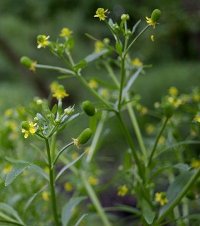 This type of buttercup, the official name of which is Ranunculus sceleratu, is a single or biennial plant with a straight, hollow and branched stem, whose height can vary from 10 to 70 cm.
This type of buttercup, the official name of which is Ranunculus sceleratu, is a single or biennial plant with a straight, hollow and branched stem, whose height can vary from 10 to 70 cm. Buttercup leaves are shiny and slightly fleshy.
The light yellow flowers of the plant do not differ in large size (for example, their diameter is 7-10 mm).
Interesting fact! Buttercup seeds are protected by the seed coat from excessive moisture (in other words, from getting wet), while under the epidermis there are large, airborne corky cells, thanks to which the seed does not sink in water.
Medical applications
Due to the high degree of poisonousness, the plant is mainly used externally. For example, the juice of a plant diluted with water is used to treat skin areas affected by a disease such as scabies. In addition, inferior eyes or festering wounds are washed with a non-concentrated juice of poisonous buttercup.
Crushed fresh leaves of the plant are applied to the warts, which contributes to their rapid removal.
Fresh ground herb buttercup poisonous can be used as an exhaust patch, to create artificial boils or blisters, as well as an effective pain relieving and distracting agent.
Water infusion of grass will help and with, for which it’s enough to hover in it.
Inside decoctions and infusions of buttercup poisonous are taken for such diseases:
- diseases of the female genital organs;
Buttercup creeping
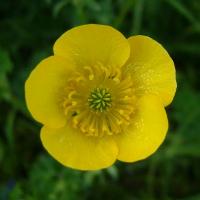 Ranunculus repens (or creeping buttercup), as well as the two species described above, is common in Russia, and is very poisonous.
Ranunculus repens (or creeping buttercup), as well as the two species described above, is common in Russia, and is very poisonous. This perennial type of buttercup, rarely exceeding 40 cm in height, has an ascending or creeping stem, which often rooted (the stem can be both naked and sometimes pubescent).
The plant is crowned with a golden-yellow, brilliant flower, which opens between May and August.
The creeping buttercup prefers moist, shaded, alluvial soils, so it can often be found on river and lake shores, forest swamps, along fields and roads.
Medical applications
In therapeutic doses, creeping buttercup has analgesic, antimicrobial, wound-healing, and tonic properties.
For diseases such as rheumatism, scrofula and scabies are applied to the affected areas (tumors and boils), grass creeping buttercup. The stem of a plant is used to resorb or accelerate the ripening of abscesses.
When the fungal lesions of the skin cover the aerial part of the plant is used as a wash or compresses.
Fresh herb buttercup topically used in the treatment of the following pathologies:
- myositis;
- rheumatic pains;
- scrofula.
The flowers of a creeping buttercup are used in the treatment of malaria, for which, 8 to 10 hours before the attack, crushed (or pounded) fresh flowers of the plant are applied to the wrists (in the area where the pulse is probed), which will help soften or stop the attack.
Important! When using a buttercup creeping as an external agent, prolonged exposure to the skin should be excluded, since this plant has a strong irritant effect on the skin (in some cases, this effect can provoke tissue necrosis and skin ulceration).
Banewort
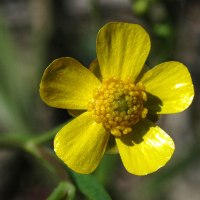 Buttercup (either Ranunculus flammula) has a short, erect or ascending stem (about 20-50 cm).
Buttercup (either Ranunculus flammula) has a short, erect or ascending stem (about 20-50 cm). The basal leaves of the plant are long-petiolate, while they are noticeably wider than the upper ones. But the top leaves of this type of buttercup are sessile.
Single light yellow flowers are quite small (no more than 12 mm in diameter). The fruit of the plant is an ovoid, single-seeded leaflet.
Buttercup is growing hot on wet soils mainly in water bodies.
Medical applications
For medicinal purposes, the herb of the plant is used, containing gamma-lactones and coumarins.
So, the juice of the above-ground part of the buttercup hot is diluted with water (2 - 3 drops of juice are used for half a glass of water) and taken in scurvy.
Infusion of the grass of this type of buttercup in folk medicine is used for. To make an infusion, one tablespoon of well-crushed fresh herb buttercup hot is poured with a liter of boiling water and infused for one hour, after which the infusion is filtered and consumed one tablespoon no more than four times a day.
Buttercup multicolor
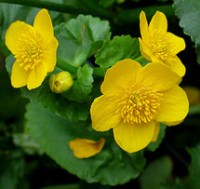 Ranunculus polyanthemus (or polymorphous ranunculus) has a high (up to 60 - 80 cm) erect and pubescent stem (leaf petioles also have a pubescence).
Ranunculus polyanthemus (or polymorphous ranunculus) has a high (up to 60 - 80 cm) erect and pubescent stem (leaf petioles also have a pubescence). The leaves of a multi-flowered buttercup have tapered or linear lobes. Bright yellow flowers, the diameter of which does not exceed 3 cm, open in the first half of June, while flowering ends in late July - early August.
This kind of buttercup in the wild is found on meadows and in forests.
Medical applications
With the purpose of treatment are used the stems, leaves and flowers of the plant containing protoanemonin, C, carotene and flavonoids.
Buttercup-based multifloral preparations with tonic, analgesic, antimicrobial and wound-healing effects are used for:
- pain syndrome of various etiologies (gastric, headaches, neuralgic pains);
- rheumatism;
- gout;
- boils;
- wounds;
- boils;
- malaria;
- skin;
Field buttercup
 The buttercup field (official name Ranunculus arvensis) prefers moderately acidic, poorly aerated, marshy and calcareous, loamy soils.
The buttercup field (official name Ranunculus arvensis) prefers moderately acidic, poorly aerated, marshy and calcareous, loamy soils. This type of buttercup has yellow or golden single apical flowers and deeply dissected leaves.
Erect and branched (almost bare) stem in height reaches 60 cm.
Field buttercup is most common in hayfields or pastures.
Preparations based on the buttercup field differ in tonic and mild laxative effects. Thus, the peel of the roots of plants and seeds are used to relieve heat and tone the body. The aboveground part of the plant is used for radiculitis, pustular skin rashes and furunculosis.
Buttercup tubers are used in the manufacture of food additives.
Buttercup water (marsh)
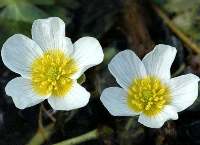 Buttercup water (it is also called swamp, while the official name of this plant is Ranunculus aquatica) is a perennial plant of light green color with a thin and bare stem, as well as small white and yellow flowers that rise above the water surface.
Buttercup water (it is also called swamp, while the official name of this plant is Ranunculus aquatica) is a perennial plant of light green color with a thin and bare stem, as well as small white and yellow flowers that rise above the water surface. Marsh buttercup can grow at a depth ranging from 20 cm to 2 m.
The length of the leaves is 3 - 4 cm, while the pedicle of the plant is not much longer than the leaves.
Buttercup flowers in a diameter equal to 8 - 12 mm in diameter.
The plant's easily falling petals are almost twice as long as the sepals. Fruits grayish up slightly bristly up.
This plant, which has white medium-sized flowers and underwater leaves, dissected into thin filamentous lobes, is common in the shallow coastal zone of Eastern countries, in Siberia, Europe, America and Africa. Buttercup grows in stagnant, and, most importantly, slowly flowing water bodies (in some cases, buttercup can be found near the coast, in sedges, as well as in overmoistened and silty soil).
For therapeutic purposes, the stems and leaves of the plant are used, containing saponins and protoanemonin.
To prepare a decoction of water buttercup, one tablespoon of the leaves of the plant should be poured with a glass of water. The product is boiled for three minutes, infused for an hour, filtered and taken 1–2 tbsp. three times a day. This decoction is used as a means of exciting the functions of the genitals.
Important! Buttercup, which has an irritating effect on the digestive tract during ingestion, is recommended to be used as a local drug and exclusively under the supervision of a physician.
Important! All of these plant species have almost identical set of useful substances, so they can be used in medicine on an equal footing.
Collection and preparation of buttercup
Medicinal raw material in buttercup is the aboveground part of the plant, which can be used both in fresh and in dried form.The plant is going to during its fruit formation, but the flowers must still be present on the stem.
When collecting raw materials, it is better not to tear off, but to carefully cut off the stem of a plant, it is important that the root, which is practically not used in medicine, remains in the ground (and the plant will benefit from the plant and the buttercup will be able to rejoice after a certain time with its beauty and healing properties).
Collected flowers, stems and leaves are thoroughly washed, and then they are sent to dry in the attic (you can dry the raw materials outdoors, but always under a canopy, because when dried under the sun, all the useful substances of the buttercup will evaporate).
Important! Buttercup is very irritating to the mucous membranes of the eyes, nose, larynx, as well as internal organs, as a result of which redness and blisters form on the skin when it comes into contact with the aerial parts of the plant. Therefore, it is recommended to collect grass of buttercup (especially caustic) in closed clothes and thick gloves.
When do buttercups bloom?
Buttercups bloom from mid-April until July (it all depends on the type of buttercup). The exception is water buttercup, which blooms from June to October.How to store?
Dried raw materials are stored in paper bags in a dark place for not more than a year. Fresh raw materials must be used immediately after collection.The composition and properties of buttercup
ProtoanemoninIt is a volatile poison that has a pungent smell and burning taste.
In small doses, this substance stimulates the functions of the central nervous system, activates the elements of the reticulo-endothelial system, neutralizes microbes and increases the content of red blood cells and hemoglobin in the blood.
Coumarins
Act:
- obstruction of blood coagulation;
- inhibition of the development of tumor cells;
- speeding up the wound healing process;
- toning the body and saturating it with vitamins of group P;
- prevention of blood clots.
Act:
- slow heart rate;
- normalization of cardiac activity;
- increased systole and diastole elongation;
- lowering blood pressure;
- normalization of blood circulation.
Act:
- promoting sputum excretion;
- heat removal;
- increased excretion of bile;
- lowering blood pressure.
This class of substances, forming a biological film, protects the tissues and cells of the body from adverse effects (we are talking about chemical, bacterial, and mechanical action). Also tannins strengthen blood vessels and constrict blood vessels significantly.
Alkaloids
Act:
- help stop bleeding;
- pain relief;
- normalization of the central nervous system;
- vessel strengthening;
- preventing the growth of neoplasms;
- pressure reduction;
- lowering body temperature.
Act:
- normalization of redox processes;
- inhibition of enzymes that destroy hyaluronic acid, which is responsible for the normal formation of cartilage tissue;
- strengthening the walls of blood vessels and increase their elasticity;
- prevention of sclerotic capillary damage;
- free radical removal.
 Act:
Act: - normalization of central nervous system functions;
- stimulation of the endocrine glands;
- facilitating the assimilation of such an essential element as iron;
- normalization of the blood;
- removal from the body of harmful compounds that provoke the development of malignant tumors.
Carotene
Act:
- reducing the risk of cancer;
- regulation of protein synthesis;
- strengthening bones and teeth and contributing to their formation;
- normalization of metabolism;
- premature process warning.
Act:
- decreased vascular tone;
- increased hemoglobin content;
- increased clearance of stones;
- binding and the subsequent removal of radionuclides.
Act:
- rejuvenation of tissues and cells of the body;
- elimination of foci of inflammation;
- regulation and normalization of metabolism; . Often, these drugs are used as an insecticide (a chemical drug designed to destroy harmful insects: for example, decoction of the plant will help to disinfect things from bedbugs).
- induce vomiting;
- take activated carbon;
- conduct a gastric lavage;
- call ambulances.
- breastfeeding period;
- individual intolerance.
Pounded buttercup flowers caustic and creeping are used in traditional medicine instead of mustard plaster and blister plaster. The flowers also help in case of aching in the lower extremities, for which it is enough to rub the diseased joints with fresh crushed flowers.
The flowers of the plant are used as a remedy for malaria.
Root and tubers
Powder from the roots and tubers of buttercup is used to treat malignant and wart removal. From the root of the plant, folk healers have long been preparing vaginal suppositories that contribute to the onset of pregnancy (self-treatment can have negative consequences, so before using folk remedies based on buttercup is necessary).Seeds
About the healing effect on the body of seeds of buttercup is quite little known: for example, there are references to the use of decoctions from the seeds of this plant, which has a basis, since buttercups have antipyretic and tonic properties.Leaves (grass)
Traditional medicine everywhere uses fresh buttercup leaves as an effective boil and anesthetics, shown in the treatment of ulcers, boils, rheumatism, scrofula, myositis. So, the grass of a buttercup is applied as an explosive plaster at old carbuncles which are not opened for a long time. Infusion of fresh leaves is used in small quantities in the treatment of headache and stomach pain.Fresh leaves of the plant in shredded form are applied to the sites of the appearance of tumors and sprains.
Buttercup is considered to be the first assistant in the removal of warts and the treatment of fungal diseases. A decoction from this part of the plant is indicated for washing the skin areas affected by the itch mite.
The gruel of fresh herb mixed with vinegar helped to cure or reduce the manifestation of diseases such as leprosy, eczema, fox disease (this is about hair loss), for which it was enough to treat the affected skin with such a mixture.
Although buttercup is not used with traditional medicine, the results of recent studies indicate that this plant effectively fights against skin tuberculosis.
It should be remembered that the buttercup is a poisonous plant, so all its parts should be taken with extreme caution and only after consulting a doctor who, if necessary, determines the exact dosage.
The use of buttercup in medicine
 Buttercup is used in both traditional and traditional medicine in eastern, northern and central European countries.
Buttercup is used in both traditional and traditional medicine in eastern, northern and central European countries. So, infusions and decoctions of dried raw materials are used in the treatment of salt deposits, all sorts of inflammation on the skin.
The herb of the plant is used as an effective painkiller for neurological, headaches, stomach and rheumatic pains.
Buttercup has been used in the treatment of colds, cancer and infectious diseases, including flu, gout, ascites, pancreatic cancer.
A decoction of flowers, taken in small quantities, will help to cope with diseases of the liver and stomach, as well as with water fear.
Fresh herb buttercup is commonly used in homeopathy in the treatment of skin diseases, and neuralgia.
Infusion
Buttercup herb infusion is taken as an internal or external remedy for skin diseases, colds, and treatment of difficult healing wounds.For the preparation of infusion 0.5 st.l. dried herbs are placed in a thermos and 500 ml of boiling water is brewed. The agent, infused for half an hour, is filtered and then used for washing wounds. When receiving an internal dosage of this infusion is 1 tbsp. three times a day. The same tool can be rinsed several times a day, inflamed mucous membrane of the throat.
Tincture
Buttercup extract has strong bactericidal, regenerating and rejuvenating properties, due to which it is used for muscle pain, sore throat and oral cavity. In addition, tincture of buttercup can be rinsed with hair, which will strengthen the hair follicle, give your hair a healthy look.50 buttercup flowers are poured over with 500 ml of alcohol, after which the product is well mixed and infused for three weeks. Filtered tincture is used externally as rubbing. Internal reception tincture is contraindicated!
Buttercup Ointment
The ointment prepared from buttercup flowers and pork fat in a ratio of 1: 4, is used as an external remedy for colds and viral diseases, for inflammation of lymph nodes. Thus, the chest and throat are rubbed with ointment (these areas of the body are wrapped with a woolen scarf and left overnight). Such treatment is carried out daily, until the disease is completely cured.Buttercup juice
Cotton wool moistened with buttercup juice is applied to sore teeth. Also, weak buttercup juice is used when it develops (it is enough to moisten the eyes with juice several times a day).Important! Strongly concentrated juice from the leaves of buttercup can provoke a burn of the skin and mucous membranes.
Single leaf buttercup: application - video
What caused such an effect on the body buttercup? The fact is that this plant contains the substance protoanemonin, which when applied topically provokes the strongest irritation of the skin of the eyes, as well as mucous eyes, nose and larynx. Such irritation is manifested by tearing, sharp eye pain, runny nose, drooling, coughing, and in some cases spasm of the larynx. With subcutaneous administration, buttercup drugs cause a rather deep damage and tissue destruction at the injection sites (up to necrosis).
Contraindications to the use of buttercup drugs are:
Buttercup Recipes

Means with heel spurs
The grass is brewed with boiling water and boiled for 10 minutes, after which the contents are poured into a basin, in which the legs are steamed until the water is completely cooled.Infusion with skin tuberculosis
3 tbsp. 400 ml of boiling water are poured over the herbs and infused for three hours. Infusion in the form of heat is applied externally in the form of lotions or compresses.Tincture with umbilical hernia
A handful of buttercup flowers pour 500 ml of vodka and insist for at least three days. Tincture is taken in a tablespoon before eating. This infusion promotes the regeneration of skin cells and has a bactericidal effect.Tincture with gout and rheumatism
10 g of fresh buttercup flowers pour 100 ml of vodka and leave to infuse for a month in a dark place. Strained tincture is used to grind sore spots.Decoction for liver diseases
1 tsp Buttercup grass is poured with two cups of boiling water, after which the agent is sent to the water bath for 15 minutes. Strained broth is drunk 1.5 tsp. three times a day.Acetic tincture for pancreatic pain
The glass is half filled with chopped herb buttercup, which is poured with 2.5 cups of 9% vinegar. Means insist one day. Take the tincture with severe pain, starting with one drop, which dissolves with water in the ratio of 1:10, with each subsequent half an hour, the dose is doubled until it is 32 drops.Buttercup is a very bright, beautiful plant, and at the same time deadly. In the old days, it was used more than once to poison detractors — if you cannot eat enough plants in a dish or drink a lot of its infusion, you will not be able to escape. At the same time, a creeping buttercup - representative of the genus Buttercup - is a valuable medicinal plant. Its medicinal properties are mainly used externally - because of the danger of poisoning, the plant eliminates “excellent” from most skin diseases and diseases of muscles, bones and joints. Botanical description of creeping buttercup, properties and contraindications, as well as recipes for the use of plants are in this article.
Buttercup creeping - description
In the old days it was believed that the buttercup became poisonous after Satan tried to hide among his thicket from Archangel Michael. However, in ancient Russia, the plant was known as the patron saint of the army, the flower of the god Perun. It was also believed that the buttercup found in the forest was for wealth, therefore many even sowed a plant near their home.
The creeping buttercup is a representative of the Buttercup family of the Buttercup family. This perennial herbaceous plant in height does not exceed 15-40 cm, its rhizome is branchy, short. The stems spread along the ground - for this kind and got its name. At the nodes, the stem tends to root, rather thick, naked, sometimes pubescent.
Bottom leaves of the plant are trifoliate, petiolate, consist of smaller diamond-like ovoid leaves. Upper leaves on the stem - sessile, separate trifoliate, lanceolate. The flowers are large (up to 3 cm), bright yellow, solitary. Flowering usually occurs throughout the summer season. The fruit is multi-tapping. The plant is poisonous, like other members of the genus.
Buttercup creeping is widely distributed throughout Europe, Asia, North Africa. In Russia, it is found almost everywhere. The plant prefers the shady shores of lakes, rivers, marshes, does not like sun, what is different from its fellows. You can also meet him in the fields and gardens, in the bushes, in the meadows.
Buttercup Creeping Plant - Composition and Healing Properties
The chemical composition of the plant is represented by a variety of biologically active substances. Particularly noteworthy is Protoanemonin, a highly toxic substance. Compared to other buttercups, there are relatively few of them here, and yet caution must be observed when collecting and treating!
The plant also found:
- Coumarins
- Saponins
- Cardiac glycosides
- Tannins
- Flavonoids (neovitexin, vitexin, saponaretin)
- Alkaloids
- Vitamin C
- Hinoin
- Carotene
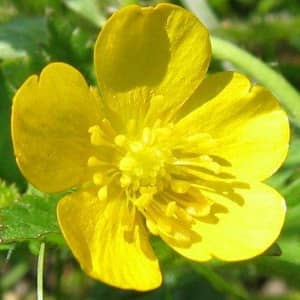
The pharmacological properties of the plant are varied. It has antimicrobial, analgesic, tonic, healing effect.
Buttercup creeping - use and contraindications
Caution with treatment with buttercup - the first thing to think about before starting therapy. Inside means with a buttercup drink in the minimum dosages and only with approval of the doctor. The herb, for the most part, is indicated for nerve pathologies such as migraine, epilepsy, and neurosis. It is also within her power to stop - with gynecological diseases, pulmonary, stomach, with hemorrhoids.
External use in folk medicine of this plant is wider. So, the buttercup perfectly heals, relieves pain in the area of cut, ulcers. They can even burn a wart, remove the spur on the sole, pull out the pus in furuncles and abscesses. Scabies mites are afraid of buttercup, and lubrication of the skin with products based on it will help defeat scabies without the use of drugs. and nails - another indication for the creeping buttercup cure.
If you make compresses or poultices with a plant, you can ease the pain, eliminate muscle spasm with a variety of diseases of the musculoskeletal and muscular system:
- Radiculitis
- Myosite
- Arthritis
- Polyarthritis
- Rheumatism
- Sciatica
- Osteochondrosis
- Arthritis
- Gout
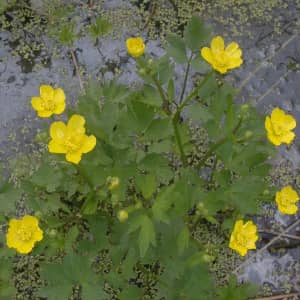
Contraindication to ingestion is the presence of any somatic illness, age up to 18 years, lactation, pregnancy, the exacerbation of all chronic diseases. When applied to the skin, prolonged exposure can lead to tissue necrosis.
Creeping Buttercup - application in traditional medicine
Medicinal raw material for this beautiful plant is the entire aboveground part. It can be used both fresh and dried. For use in the cold season, buttercup is harvested during the period of fruit formation, as more nutrients will be present. Some flowers still have to be on the plants. The collection should be done with gloves, as the grass can cause allergic reactions on the skin.
During harvesting, carefully cut the stems without damaging the root. It is not used in medicine, its medicinal properties have not been established. The plant is dried in the attic, under a shed, or in another open air space, but without access to sunlight. Store dried raw materials in a paper bag for about one year. Fresh plant is usually applied immediately after harvest.
From abscesses and abscesses
For the resorption of ulcers located on the surface of the body, a creeping buttercup fits perfectly. Fresh plants need to be washed, mashed slightly in the hands, then apply to the sore spot. Tie the grass with a bandage, leave for 15 minutes. Repeat the procedure twice a day until the abscess has matured.
From myositis
With muscle soreness and inflammation, it is used in folk medicine as a creeping buttercup in a dry form. The grass with flowers steamed with boiling water, let cool. In the form of heat to the muscle, hold for about 10 minutes. Apply as needed. The same recipe is suitable for sciatica, rheumatism, osteochondrosis, arthrosis.
From leg cramps
When aching legs at night, chop the fresh grass of the plant into mush, rubbing the diseased area of the body. Repeat the procedure daily until relief.
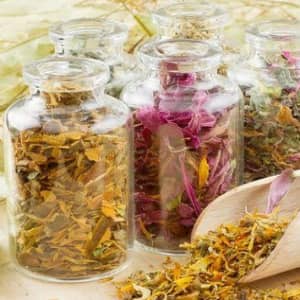
From scabies
Brew 50 g of buttercup grass with half a liter of boiling water, leave for an hour for infusion. Then drain the tool, apply for washing the affected parts of the body. It is necessary to be treated in this way for scabies for at least 5 days.
From warts
Squeeze the juice of grass buttercup creeping. Lubricate them wart twice a day before the disappearance.
From epilepsy
Internal use of buttercup based products must be very careful, it is carried out only under the supervision of a specialist! From epilepsy, the plant is applied as follows: brew a teaspoon of grass with a glass of boiling water, leave for 30 minutes. Drink a dessert spoon twice a day. The same method is suitable for edema, dropsy, uterine bleeding.
Buttercup creeping delivers a lot of trouble to gardeners with their ability to form new plants. At the same time, it is widely used in folk medicine due to its healing properties.
Appearance
This perennial herb belongs to the family of buttercups, which has about 600 species. Rhizome short (no more than 2 cm) and branched. Stem creeping or ascending, thick and juicy, may be bare or covered with distant hairs. Buttercup creeping does not apply to tall plants, its height rarely exceeds 40 cm.
Bottom leaves are a rounded heart-shaped plate on an elongated petiole. Almost to the very base, they are cut into 5 segments, cut into sharp three-toothed lobes. Upper leaves sessile, also divided into segments. The leaves on both sides are covered with pressed hairs and have a paler color on the inside.
Flowers are usually very numerous, located on long peduncles, their diameter can be from 2 to 3 cm. Each flower consists of five bright yellow petals and numerous pistils and stamens. Buttercup blooms from early June until late autumn. Then a fruit is formed on it - a collective seed. After shedding, the seeds germinate very slowly, best of all they sprout after wintering. The creeping buttercup, the photo of which is posted in this article, has a very interesting feature - it throws forward the stem, which takes root in a suitable place, forms an outlet and goes further. The speed of its spread is large enough. In a short time, the buttercup is covered with a rather big territory, if no measures are taken against it.
Places of growth
Almost everywhere this flower grows. It can be found in Europe, Western Siberia, the Caucasus, Asia and Africa. Favorite places for him are shaded areas located along the shores of lakes, rivers, wet meadows, forest swamps, fields. Buttercup prefers mainly rich in nutrients heavy soils and peatlands. 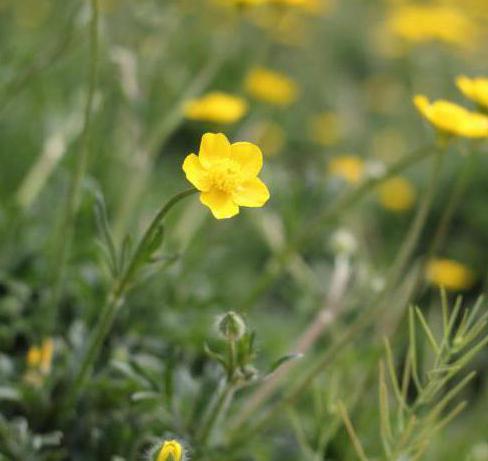
Poisonous properties
The creeping buttercup, described above, belongs to the category of poisonous plants. And those are all its parts. This is due to their high content of esters, protoanemonin, ranunculin and flavonoids. These substances can have a damaging effect on the heart, digestive organs and kidneys, stimulate the nervous system.
Avoid getting the plant juice inside - it can cause a burning sensation in the mouth and stomach. As a result, vomiting, excessive salivation and abdominal pain appear. Sometimes, in severe cases, poisoning with buttercup poison leads to convulsions and loss of consciousness. Even getting juice on the skin often leads to a burn.
Use in traditional medicine
As a medicine, creeping buttercup has been used for a long time. In folk medicine, there are many different recipes, when the use of this plant helps to cure some diseases. Substances that are part of the buttercup, which have an irritating effect when applied topically, in small dosages can increase the number of red blood cells in the blood, stimulate the nervous system, have an antimicrobial effect, eliminating the body from pathogens of Staphylococcus and Escherichia coli.

The bactericidal, wound-healing and analgesic action of the buttercup has long been used to treat gout, rheumatism, sciatica and arthritis. Creeping buttercup is very effective against skin diseases. The gruel prepared from the leaves of this plant successfully treats fungal skin diseases, scabies, and warts. Pounded into powder, the leaves and flowers were used in the old days instead of mustard plaster, and also applied to boils and boils, which accelerated their maturation.
When using buttercup as a medicine, you should not forget that this is a poisonous plant, and therefore it is necessary to avoid getting its juice on wounds, scratches and cuts.
Collecting and harvesting
All parts of the plant except the root have healing properties. Raw materials harvested during the entire period of flowering buttercup. At the same time, you must take precautions and be sure to use gloves. The stalk is very carefully torn off or cut off with scissors in order not to damage the root. The collected grass is recommended to be washed and spread out in the shade to dry. In no case can it be dried in the sun, otherwise there will be no trace of all the beneficial properties that a creeping buttercup has. Using it for therapeutic purposes will be absolutely not effective. 
It is best to dry the flowers and leaves of the plant as a whole, without cutting them into pieces, since in the future they may be needed in this form. You can grind them at any time.
Recipes
All homemade products made from buttercup, it is recommended to use only externally. Do not use them inside.
Infusion for compresses and lotions: 3 tablespoons of herbs pour two cups of boiling water and leave for 3 hours to infuse in a warm place.
Decoction for the treatment of skin diseases: boil the grass with boiling water, simmer for 10 minutes over low heat.
Buttercup creeping is a perennial herb, endowed with hooked roots. The stem of this plant is high, its height will fluctuate between thirty and eighty centimeters. Such a creeping buttercup stalk will be branched, straight and furrowed, it can be either naked or endowed with distal hairs to the middle. The basal leaves of this plant are endowed with a rounded heart-shaped plate in outline and a rather long, bulged hairy stem. Bottom leaves almost to the very base will be three- and five-membered lobes, which will be elongated lanceolate and upward somewhat broadening, as well as also notched serrated. The upper stem leaves of a creeping buttercup will be two-fold and four-split into toothed or linear-lanceolate whole lobes. It is noteworthy that the leaves of this plant are endowed with pressed hairs on both sides, and from below they will be painted in pale green tones. Peduncles of this plant are endowed with adpressed hairs. Usually creeping buttercup flowers will be numerous, and their diameter is about two to three centimeters. The sepals of this plant are blunt, ovoid, on the edge they will be endowed with distant hairs. Most often, creeping buttercup petals are only five to seven pieces, and they will be painted in bright yellow tones. It is noteworthy that the receptacle of this plant is hairy. The fruit of a creeping buttercup is a group seed, which will consist of many seeds.Under natural conditions, this plant is found on the territory of Western Siberia, the mountains of Central Asia, in the south of Eastern Siberia, in the European part of Russia, in Ukraine and in Belarus. For growth, this plant prefers light forests, meadows, edges, glades, embankments, gardens, places among fields, dry flood plain and dry meadows.
The flowering of a creeping buttercup falls on a period starting in June and ending in August.
Description of the medicinal properties of creeping buttercup
Buttercup creeping endowed with very valuable healing properties, while for therapeutic purposes it is recommended to use the grass of this plant. The concept of grass includes flowers, leaves and stems of this plant. It is recommended to harvest such medicinal raw materials throughout the entire period of flowering of the creeping buttercup.The presence of such valuable healing properties should be explained by the content of carotene, quinoin, saponins, ascorbic acid, tannins, coumarins, alkaloids, flavonoids and lactones in the composition of this plant.
It should be noted that this plant is poisonous, for this reason it is recommended to exercise extreme caution when handling this plant. creeping buttercup grass should be used externally and as compresses for gout, rheumatism, wounds, boils, headache and neuralgia.
A decoction made on the basis of creeping buttercup grass is recommended for washing the skin that has been affected by scabies. In addition, it is recommended and apply the crushed fresh leaves of this plant to abscesses and abscesses in order to accelerate their maturation. With proper use of such curative remedies based on a creeping buttercup, they are very effective and the positive effect will be noticeable rather quickly.

